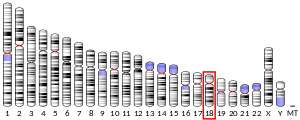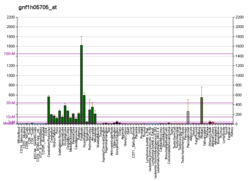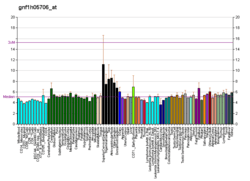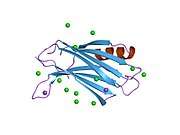SYT4
Synaptotagmin-4 is a protein that in humans is encoded by the SYT4 gene.[5][6]
References
- 1 2 3 GRCh38: Ensembl release 89: ENSG00000132872 - Ensembl, May 2017
- 1 2 3 GRCm38: Ensembl release 89: ENSMUSG00000024261 - Ensembl, May 2017
- ↑ "Human PubMed Reference:".
- ↑ "Mouse PubMed Reference:".
- ↑ Hilbush BS, Morgan JI (Sep 1994). "A third synaptotagmin gene, Syt3, in the mouse". Proc Natl Acad Sci U S A. 91 (17): 8195–9. doi:10.1073/pnas.91.17.8195. PMC 44572. PMID 8058779.
- ↑ "Entrez Gene: SYT4 synaptotagmin IV".
Further reading
- Ullrich B, Li C, Zhang JZ, et al. (1995). "Functional properties of multiple synaptotagmins in brain". Neuron. 13 (6): 1281–91. doi:10.1016/0896-6273(94)90415-4. PMID 7993622.
- Perin MS (1996). "Mirror image motifs mediate the interaction of the COOH terminus of multiple synaptotagmins with the neurexins and calmodulin". Biochemistry. 35 (43): 13808–16. doi:10.1021/bi960853x. PMID 8901523.
- Thomas DM, Ferguson GD, Herschman HR, Elferink LA (1999). "Functional and biochemical analysis of the C2 domains of synaptotagmin IV". Mol. Biol. Cell. 10 (7): 2285–95. doi:10.1091/mbc.10.7.2285. PMC 25443. PMID 10397765.
- Nagase T, Kikuno R, Ishikawa KI, et al. (2000). "Prediction of the coding sequences of unidentified human genes. XVI. The complete sequences of 150 new cDNA clones from brain which code for large proteins in vitro". DNA Res. 7 (1): 65–73. doi:10.1093/dnares/7.1.65. PMID 10718198.
- Mizutani A, Fukuda M, Ibata K, et al. (2000). "SYNCRIP, a cytoplasmic counterpart of heterogeneous nuclear ribonucleoprotein R, interacts with ubiquitous synaptotagmin isoforms". J. Biol. Chem. 275 (13): 9823–31. doi:10.1074/jbc.275.13.9823. PMID 10734137.
- Ferguson GD, Chen XN, Korenberg JR, Herschman HR (2001). "The human synaptotagmin IV gene defines an evolutionary break point between syntenic mouse and human chromosome regions but retains ligand inducibility and tissue specificity". J. Biol. Chem. 275 (47): 36920–6. doi:10.1074/jbc.M005801200. PMID 10938284.
- Strausberg RL, Feingold EA, Grouse LH, et al. (2003). "Generation and initial analysis of more than 15,000 full-length human and mouse cDNA sequences". Proc. Natl. Acad. Sci. U.S.A. 99 (26): 16899–903. doi:10.1073/pnas.242603899. PMC 139241. PMID 12477932.
- Gerhard DS, Wagner L, Feingold EA, et al. (2004). "The status, quality, and expansion of the NIH full-length cDNA project: the Mammalian Gene Collection (MGC)". Genome Res. 14 (10B): 2121–7. doi:10.1101/gr.2596504. PMC 528928. PMID 15489334.
- Rual JF, Venkatesan K, Hao T, et al. (2005). "Towards a proteome-scale map of the human protein-protein interaction network". Nature. 437 (7062): 1173–8. doi:10.1038/nature04209. PMID 16189514.
This article is issued from
Wikipedia.
The text is licensed under Creative Commons - Attribution - Sharealike.
Additional terms may apply for the media files.









